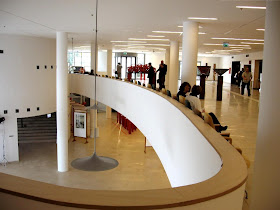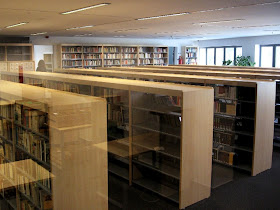The new South Transdanubian Regional Library and Knowledge Centre in Pécs: report of a visit made in September 2010
While librarians and the government in the UK are wringing their hands over the future of libraries, in Hungary they are getting on and building them. Of course such undertakings are made easier when there are milliards of forints of EU money sloshing around, and the city in question is sharing the title of European Capital of Culture for 2010. On a recent visit to Pécs it was possible for us to join a visit of local librarians to the impressive new building which will bring together in an innovative way the Pécs city, Baranya county and the University libraries in what is being termed the region's "Knowledge Centre". The following notes are impressions from that brief visit, and do not result from consultation of the architectural briefs or management plans. We are most grateful to the staff who devoted time to us and any criticisms or reservations that may become apparent do not reflect on their dedication and commitment to this dauntingly complex project.
At the time of our visit in September 2010 only the floors with the subject areas managed by the university were operating; the public library floors were still being prepared and much of the equipment was still to be installed. There will eventually be 400 computer work stations and wifi throughout the building. Moving stock from so many different libraries and leaving enough space to integrate them must have been a nightmare but that aspect seems to have run like clockwork – it took three weeks to move more than one million documents! However overall the 4,000,000,000 forint project (about £12,500,000) is behind schedule as it was intended to be fully open in the spring of 2010.
The building is on seven floors with a total of 12,000 square metres of floor space: a sub-basement and basement, largely given over to stores and services, including a binding and conservation section, a ground floor which provides an entrance hall, registration and security turnstiles and four floors with public reading areas. Staff areas are controlled by swipe cards and we were not shown behind the scenes on this visit. The entrance hall is massive, in bare shining marble and somewhat daunting as it waits for a coffee lounge to be installed and hopefully some potted plants to add patches of colour.
There are two wings to the building, the main facade of which is intended to represent an open book. Much of this facade is clad in glass with a ripple pattern imprinted in white which hopefully will cut down glare during the summers, which can be very hot in southern Hungary. Inside everywhere looks stunningly light, clean and uncluttered, with pale maplewood used throughout for shelves, tables, desks and computer fitments. There are new, suede-covered computer chairs and loungers in attractive shades of pale green, beige and lemon - how will the covered arms look in a few years time?




The building is only partly modular and areas of each floor are given over to curving features with a central well extending through all public levels and a massive beehive shaped structure lined internally with many thousands of brightly coloured ceramic tiles from the local Zsolnay factory in Pecs. This extends from the basement to a light well in the middle of an enclosed terrace area on the roof.



There are also red glass sculptures from Romania scattered around the entrance levels, although it is not clear if these are to be a permanent feature or merely a temporary opening exhibition. Rather more peculiar are the oversized specimen flasks which are also on display.


The first floor is given over to the public library functions and it is here that the main collections of literature and fiction are to be found as well as other popular subject areas.



The main reading room is located on the second floor, which is run by the University Library. Its high ceiling extends up three floors and lighting is entirely natural during daylight hours.


On the second floor are also to be found some special collections such as the ethnic minorities collection, catering for Serbian, Croatian, Swabian, Roma and other minorities, and the local studies collection. There is a seminar room for class visits decorated as a memorial to a notable former librarian Csorba Gyözö (1916-1995) after whom the Baranya County Library was named. There are also other meeting and lecture rooms in the building.





The fourth floor houses the collections of the law and economics faculties of the university, including a special collection of east European law and the European Documentation Centre.


The music and children's library share the fifth floor with access onto an enclosed rooftop courtyard. At the entrance to the children's library there is an exhibition of ceramics made by local children, and the section has a well-equipped activity room looking onto the courtyard. Also looking onto the courtyard is a small recital room where a collection of historical gramophone records is held. This collection is being digitised. The music library has large collections of CDs, scores and part music, vital in a city with such a lively cultural life.









The whole edifice is extremely impressive and magnificent for a town of under 200,000 people and there are though many positive things about the integrated service. Far more resources will be available for the public and there will be economies of purchase with no need to duplicate resources, for example only one set of government papers and official documents will need to be acquired in future. There will be far more online resources and all staff will become more adaptable with new opportunities for career progression.

However there are a number of worries that only time will prove to be unfounded. Although convenient for some sections of the university, the new building is located some distance to the east of the historic city centre, beyond the intersection of two busy four-lane highways. This may place obstacles in the path of casual public library users. Also the sheer size of the new structure could prove intimidating to those used to the more informal and old-fashioned atmosphere of the City and County Libraries. How will a parent with a baby buggy or a school class negotiate their way up to the fifth floor, even if there are lifts? The architect had ideas which did not always tie in with what librarians would have liked - for example no indoor plants to spoil the sleek lines - although we noticed that some had made a discrete appearance. There were also no handrails on the stairs, whose black colour scheme made them rather dark after the bright decor of the reading rooms. The floors of the reading rooms are carpeted but as much of the building is open-plan it is possible that the activities of the children's and music departments will interfere with the tranquillity of the research and study areas below.
Discussions revealed that there are also worries for staff, particularly some of the public library staff who fear that they will be overshadowed by the university, and a prey to students who they feel to be arrogant and demanding. They fear that, as much of the future purchasing and running costs will be from the centrally funded university, they will inevitably make most of the decisions and the locally funded public service will be side-lined. It will certainly be curious to see how university lecturers and students enjoy using the resources alongside school groups, toddlers and technophobic pensioners wanting to read the newspapers or find a nice romantic novel! One example of non-communication cited to us related to the merging of the catalogues. Both the university and public libraries have migrated to the Corvinus system but the databases are incompatible and tests to merge them have so far proved to be inconclusive. The three days down time for the final merging of the databases had been decided by the university, which is responsible for systems management, coinciding with the Hungarian library week, an event in which only the public library is involved. Such issues will no doubt be resolved, and it was not possible to discover what arrangements have been made for access to electronic resources. Certainly all users will have equal access to all printed and audiovisual resources for consultation and loan. The stock is colour coded to reflect the floor on which it is housed and also, presumably, the ownership of items.
A network of four branch libraries will also remain, and will no doubt continue to serve their local communities. Several librarians who had been offered the opportunity to move to the new building had decided to remain with their branches. There is also a mobile library operating from the new building. The university will also retain a number of departmental and faculty libraries elsewhere in the town. For example the fine arts library will be moving to the cultural complex being created in the former Zsolnay factory and the historic Bishop Klimo Library of the University will remain as a rare books cllection in the old university building in the centre of the city.


Ian and Jill Maxted
September 2010